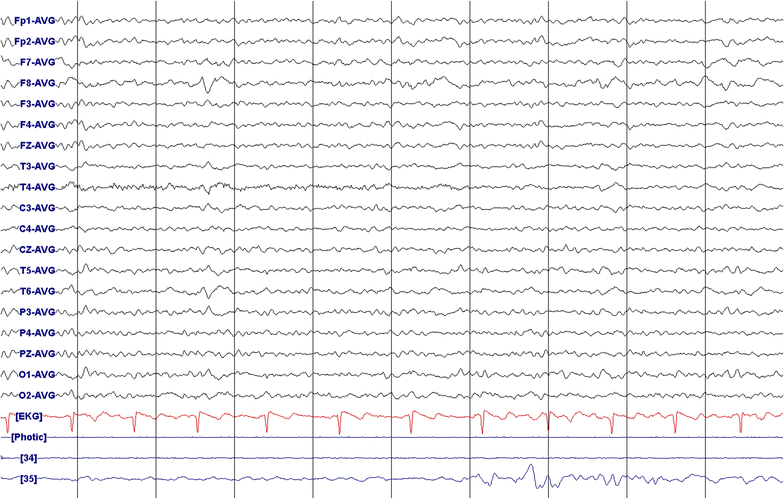Neurosyphilis as a great imitator: a case report
- PMID: 27465246
- PMCID: PMC4964046
- DOI: 10.1186/s13104-016-2176-2
Neurosyphilis as a great imitator: a case report
Abstract
Background: Neurosyphilis is defined as any involvement of the central nervous system by the bacterium Treponema pallidum. Movement disorders as manifestations of syphilis have been reported quite rarely.
Case presentation: We report a case of a 42-year-old Russian man living in Estonia with rapidly progressive dementia and movement disorders manifesting as myoclonus, cerebellar ataxia and parkinsonism. The mini mental state examination score was 12/30. After excluding different neurodegenerative causes, further diagnostic testing was consistent with neurosyphilis. Treatment with penicillin was started and 6 months later his mini mental state examination score was 25/30 and he had no myoclonus, parkinsonism or cerebellar dysfunction.
Conclusion: Since syphilis is easily diagnosed and treatable, it should be considered and tested in patients with cognitive impairment and movement disorders.
Keywords: Dementia; Movement disorders; Neurosyphilis.
Figures


Similar articles
-
[Neurosyphilis, the great imitator: a diagnostic challenge].Ned Tijdschr Geneeskd. 2013;157(30):A6033. Ned Tijdschr Geneeskd. 2013. PMID: 23890167 Dutch.
-
Early neurosyphilis presenting with facial palsy and an oral ulcer in a patient who is human immunodeficiency virus positive: a case report.J Med Case Rep. 2017 May 13;11(1):134. doi: 10.1186/s13256-017-1297-0. J Med Case Rep. 2017. PMID: 28499407 Free PMC article.
-
Prolonged neuropsychiatric symptoms may delay the diagnosis of parkinsonism secondary to neurosyphilis.Sex Transm Infect. 2022 Mar;98(2):157. doi: 10.1136/sextrans-2021-055327. Epub 2021 Dec 9. Sex Transm Infect. 2022. PMID: 34887353 No abstract available.
-
Neurosyphilis.Infect Dis Clin North Am. 1994 Dec;8(4):769-95. Infect Dis Clin North Am. 1994. PMID: 7890932 Review.
-
Rapid progression to gummatous syphilitic hepatitis and neurosyphilis in a patient with newly-diagnosed HIV.Int J STD AIDS. 2015 Nov;26(13):985-7. doi: 10.1177/0956462414564401. Epub 2014 Dec 17. Int J STD AIDS. 2015. PMID: 25525055 Review.
Cited by
-
Atypical Presentations of Neurosyphilis: The Great Imitator Revisited.Cureus. 2025 Jul 16;17(7):e88088. doi: 10.7759/cureus.88088. eCollection 2025 Jul. Cureus. 2025. PMID: 40821312 Free PMC article.
-
Neurosyphilis: A Monkey Among Men.J Community Hosp Intern Med Perspect. 2022 May 2;12(3):57-60. doi: 10.55729/2000-9666.1055. eCollection 2022. J Community Hosp Intern Med Perspect. 2022. PMID: 35711403 Free PMC article.
-
Three cases of neurosyphilis diagnosed in the 21st century: A case report.Exp Ther Med. 2023 Mar 21;25(5):201. doi: 10.3892/etm.2023.11900. eCollection 2023 May. Exp Ther Med. 2023. PMID: 37090068 Free PMC article.
-
Incidence of asymptomatic neurosyphilis in serofast Chinese syphilis patients.Sci Rep. 2017 Nov 13;7(1):15456. doi: 10.1038/s41598-017-15641-w. Sci Rep. 2017. PMID: 29133821 Free PMC article.
-
Paroxysmal sympathetic hyperactivity caused by neurosyphilis.BMJ Neurol Open. 2024 Oct 15;6(2):e000814. doi: 10.1136/bmjno-2024-000814. eCollection 2024. BMJ Neurol Open. 2024. PMID: 39415898 Free PMC article.
References
Publication types
MeSH terms
Substances
Supplementary concepts
LinkOut - more resources
Full Text Sources
Other Literature Sources
Medical

